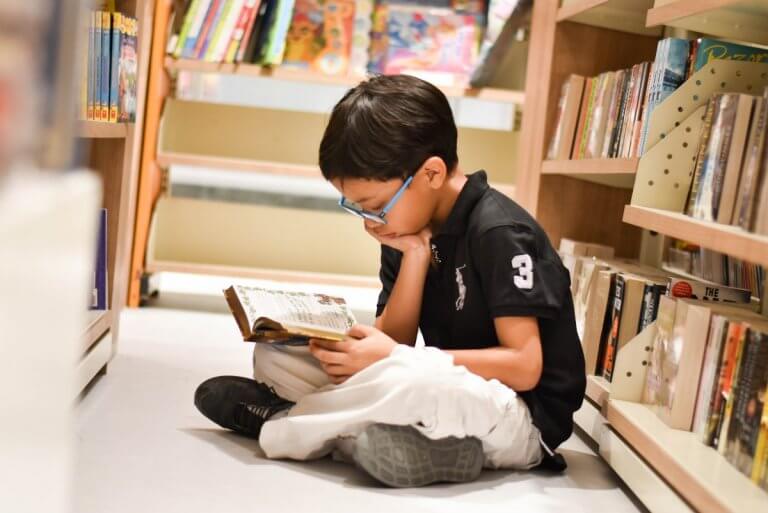
In the age of social media, iPads and computers, children are not reading books as often as they should, or starting as young as they should, leading to worrying drops in literacy rates across several countries.
The issue is not unique to one country or region; whether in Europe, Asia-Pacific or America, social media penetration among the youth is at an all-time high. And with so many hours of the day dedicated to social media, children are naturally spending less time engrossed in books.
A study last year by the University College London (UCL) looked at the habits of 11,000 children who were tracked from their birth in 2000. Researchers found that their time on social media could be the main cause of distraction when it came to reading and homework, thus affecting their literacy rates.
Professor Yvonne Kelly, Director of UCL’s International Centre for Lifecourse Studies, said the findings suggested a link between “the amount of time young people spend on social media and their levels of literacy”.
“We looked at whether the more time young people spend on social media, the less time they have for the things that might improve their literacy such as reading for enjoyment and doing homework,” said Professor Kelly.
Creative ways to encourage reading
With the worrying drop in literacy rates, it’s no wonder that efforts are being ramped up worldwide to promote reading in children.
Many schools and companies are trying innovative new methods to encourage children to read and improve child literacy.
One elementary school in Umatilla, Florida, recently unveiled a vending machine that doesn’t dispense snacks or drinks – it serves up books instead.
The unveiling was held as part of the state’s literacy week, according to CNN. To encourage students to use it, the school promotes the use of the vending machine books as a ‘reward’.

Children at Umatilla Elementary School can ‘buy’ books with Bulldog Bucks. Source: CNN
When students do good deeds or make good choices such as being kind to others and doing their homework, they get rewarded with ‘Bulldog Bucks’.
Then, they see the school’s media specialist, Susan Caldwell, who is in charge of the library, book fair and the new vending machine. She takes their ‘bucks’ and gives them coins in exchange, which they can use at the machine to choose their book of choice.
“The kids were so excited, they were trying to buy books out of it before we even unveiled it,” said Umatilla Elementary School Principal Dianne Dwyer.
The books cover a variety of reading skill levels and ‘cost’ 50 cents.
“We call them ‘forever books’. Because we want the kids to take them home, read them with friends, share them with family. It’s a free book for them to keep. But really, it doesn’t cost them anything, they just have to make good choices.”
This isn’t the first vending machine of its kind. In December last year, a school in Buffalo, New York, also unveiled a similar machine. In fact, it was their online post about it that inspired Umatilla Elementary School to introduce their own.
Meanwhile, students of Mundelein High in Illinois returned from their winter break recently to find six floor-to-ceiling book covers lining the school’s English department’s corridor.
The covers were wrapped around sections of the wall, making them look like giant books. The school explained in a Facebook post that a “routine hallway has been transformed into a giant motivational tableau to encourage reading.”
School spokesman Ron Girard told the BBC that the aim of the project was to “get students talking about the reading that they do”.
“That usually occurs in classrooms but now the chatter among students even takes place in the hallways when they see images of books they have read.”
The project made waves on social media, even attracting the attention of one of the featured authors Jason Reynolds who, along with Kiely Brendan, wrote All American Boys, who shared a picture of the mural on his Twitter account.
Whoaaaaa! @KielyBrendan https://t.co/xQqTsnqsKX
— Jason Reynolds (@JasonReynolds83) January 5, 2019
By linking reading with more popular interests such as sports or games, there is a higher chance that books will pique a child’s interest.
At East Side Elementary School in Missisipi, teachers known as ‘reading cheerleaders’ are using the popularity of football to encourage young students to read.
Dubbed ‘The First Quarter of Literacy Week’, with a cheeky reference to football, the effort would coincide with the Super Bowl.
The school partnered with athletes and former football stars who donated books to students. All students will go home with five new books.
“We set the foundation in Pre-K and Kindergarten because it is so important that we foster that love of reading at an early age. These children need to know how to read in order to be successful in life so we are thankful for the Chris Long Foundation,” said librarian Melissa McKinney.
How companies are doing their part
They say it takes a village when it comes to raising children; after all, it’s everyone’s responsibility and a community effort to make sure the current generation grow up to become responsible and literate citizens.
Besides schools and parents, some companies are also making efforts to promote literacy in children.
According to NZ Herald, McDonald’s are trading their Happy Meal toys for Roald Dahl books over the next six weeks.
The company plans to distribute a total of 800,000 books from the famous children’s author, as part of its Happy Meal Readers programme.
It’s not really a new effort as McDonald’s New Zealand has actually held several book campaigns over the past decade, but books were only permanently added as an option in 2017.

Roald Dahl’s famous works are being added to Happy Meals in New Zealand. Source: Dadness
After the distribution of 800,000 Roald Dahl books, McDonald’s would have provided more than three million books in New Zealand and close to 450 million books globally.
“The Happy Meal Readers programme is all about helping parents to get their children to enjoy reading,” said Jo Mitchell, Director of Marketing at McDonald’s New Zealand.
“The Roald Dahl characters are ones that many parents will have enjoyed growing up, and it’s great to play a part in introducing them to a new generation.”
This initiative was in response to a 2016 survey from The Progress in International Reading Literacy Study, which found that many Kiwi adults were unable to read at a day-to-day functioning level, and also showed a worrying drop in the literacy rate among primary school-aged children.
McDonald’s is not the only fast food joint to tackle child literacy, as last year, Pizza Hut teamed up with NFL Star Todd Gurley to inspire young readers.
Nearly 35 years after launching its iconic BOOK IT! programme, Pizza Hut joined forces with NFL player ambassadors and team partners to highlight the importance of reading to kids and parents, and raise funds for the non-profit ‘First Book’, dedicated to creating equal access to quality education for children in need.
Todd advocated for literacy as part of the NFL’s ‘My Cause My Cleats’ initiative, wearing custom-designed Nike cleats which promoted reading during the LA Rams home game on December 16 last year.
The cleats featured Todd’s children’s book of choice, The Magician’s Hat, written by fellow NFL player Malcolm Mitchell.
Meanwhile, in the UK, renowned footwear brand Clarks is doing its part to improve child literacy. They have recently joined a new Department of Education initiative designed to address the growing literacy crisis that costs the economy nearly $3.3 billion annually, according to the National Literacy Trust.
Along with other companies such as Lego, WHSmith, HarperCollins and KPMG, Clarks will train its roughly 6,500 retail staff to teach its young customers early language skills while they are fitting them for new shoes. It will happen over the summer so that employees are ready for the back-to-school rush in the fall.
This campaign is part of a larger project by the UK government to address the alarming rates of early literacy and communication problems among children from disadvantaged families.
Liked this? Then you’ll love…
Saudi Arabia to eradicate illiteracy by 2024
Students may need this skill as much as maths and literacy to succeed in life







